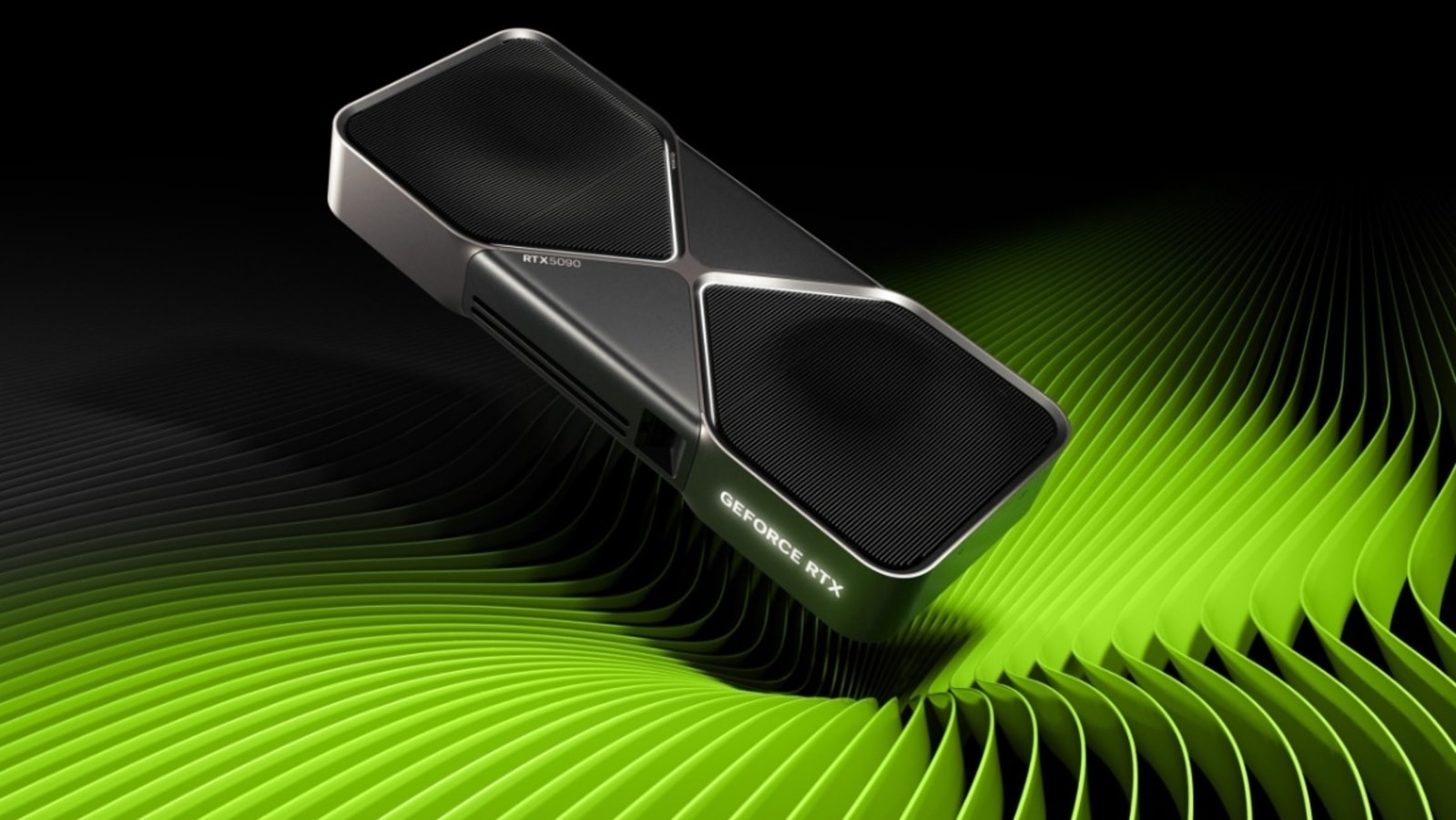A wireless speaker that can pull double duties as an Internet radio, but the BoomBocs Studio is undone by some underwhelming audio.
Pros
- Wi-Fi and Bluetooth for less than £150
- Trendy look
- Music streaming support
Cons
- Below par sound short of definition, detail, and bass
- Navigation on speaker can be long-winded
- Noisy signal
Availability
- UKRRP: £149
- USATBC
- EuropeTBC
- CanadaTBC
- AustraliaTBC
-
Music streamingSupports Amazon Music, Deezer, Spotify Connect and Internet radio -
RadioTwo alarms and sleep/snooze functionality -
Undok appApp for controlling device on mobile (Android/iOS)
Introduction
Are you old enough to remember a boombox? If not, perhaps a history lesson is required.
Back in the eighties, people would haul humongous speakers around, slip in a cassette and let rip on a street for everyone to hear (even if they didn’t want to). Play the right music, and it was a party starter.
Of course, we’re no longer in the 1980s, and speakers are small enough to be carried with one hand. The BoomBocs Studio fits such a description and is filled with modern tech such as Bluetooth and Wi-Fi connectivity.
Revivifying the 80s is all well and good, but the BoomBocs Studio needs to be more than a melding of nostalgia and modern sensibilities to have an impact.
Design
- Rotary dials for control
- LCD display
- Comes in a range of colours
The BoomBocs Studio is larger than most wireless speakers, but still compact enough to perch on a tabletop or desk, though not enclosed within a closed bookshelf as it requires air for ventilation.
It comes in a variety of quirkily named and snazzy colour options such as Green Quartz, Dahlia Orange, Pink Charlotte, Brilliant White and Bold Black. There’s a slight indentation in the middle that gives the Studio an angular look, casting the speaker in two shades when light shines upon it.
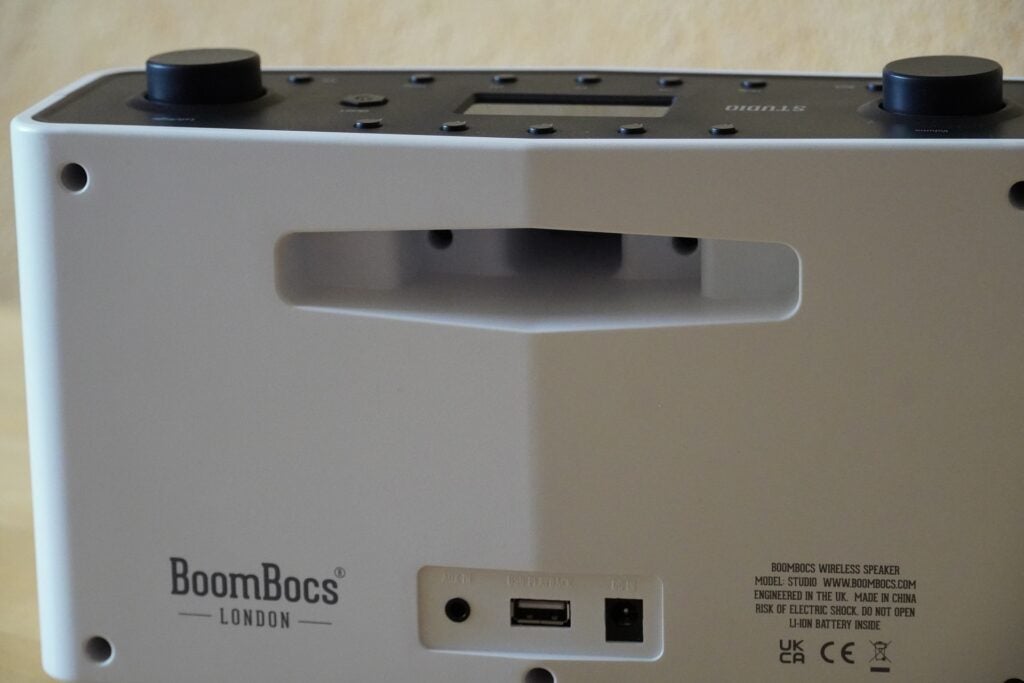
Around the rear is an integrated handle for carry, the speaker weighs a lightweight 1.43 kg. That’s less than the Apple HomePod 2 and less than ‘portable’ speakers such as the Sonos Move and Sony SRS-XG300.
At the bottom are 3.5mm aux in and type-A USB ports for playback plus an input for the power supply.
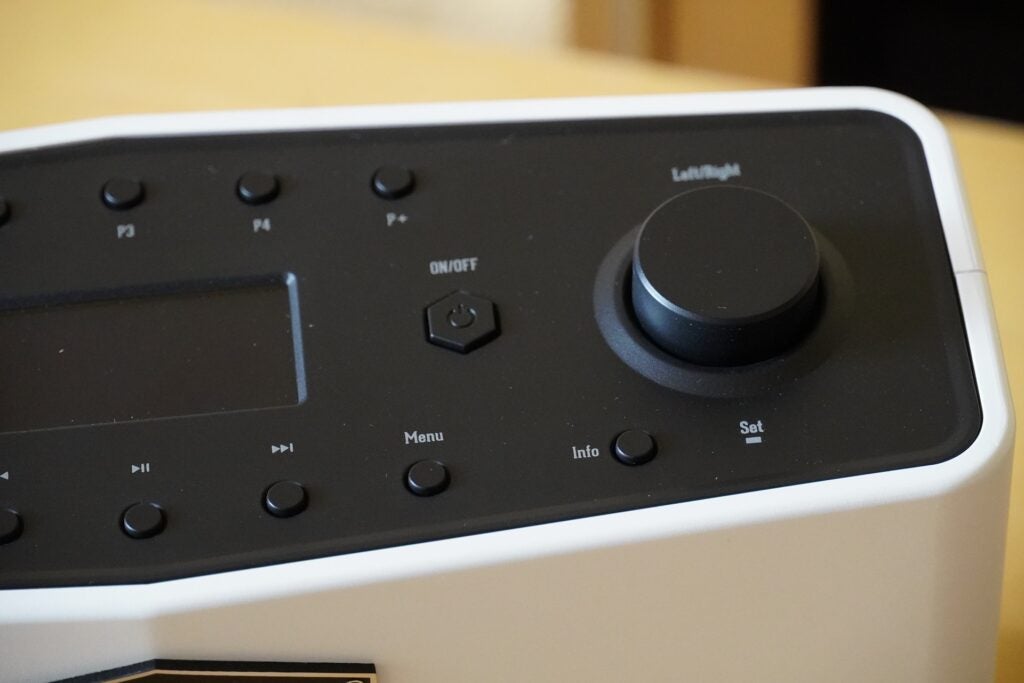
Up top are two rotary dials: one for volume and another for navigation. And slap bam in the middle is a 2.4-inch LCD display. It is (sort of) visible from afar but you’ll need to be hovering over to read the text. Above that screen are five programmable presets and below are buttons for playback, menu, info etc.
I do like the tactility of the dials and buttons, it gives the speaker a playful, toy-like sensibility, though some (but not all) of the menu settings and search capabilities are rendered pointless by also being available in the Undok app, so you won’t need to use them as much if you have a smartphone.
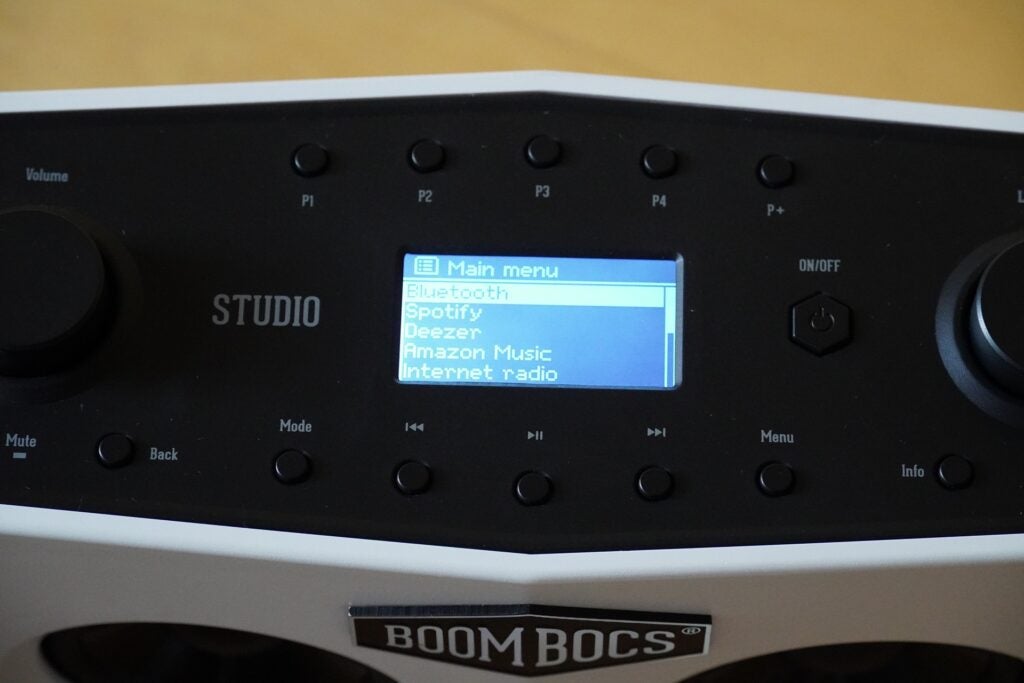
Features
- Wi-Fi and Bluetooth connectivity
- Up to 15 hours battery life
- Four presets for each source
There aren’t many wireless speakers below £150 that offer Bluetooth 5.0 and Wi-Fi, but the BoomBocs has both, permitting access to the likes of Spotify Connect, Deezer, Amazon Music, Internet radio and podcasts. Chromecast and AirPlay aren’t included but that level of support is rare at this price.
And the BoomBocs Studio functions as a radio too, with alarm capability (two of them) and sleep/snooze support too –the last feature is one the similarly specced (and more expensive) Pure Evoke Play leaves off its list.
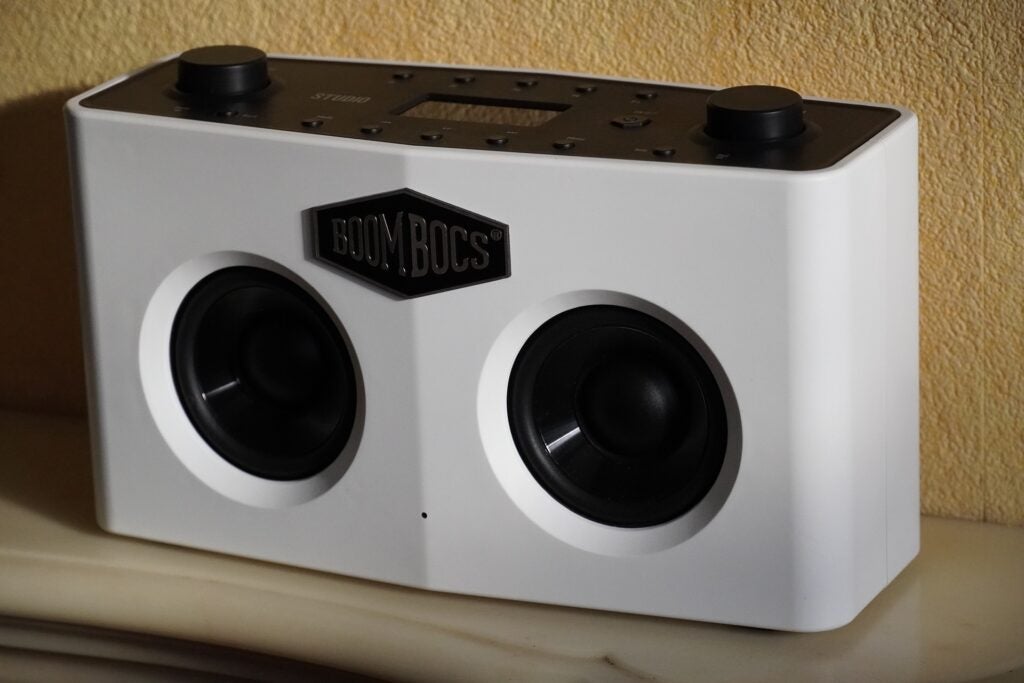
The rechargeable battery is rated in the region of 10-15 hours (15 for Bluetooth, 12 with Wi-Fi) and though the BoomBocs comes with a power adapter, it runs off the internal battery and only needs the adapter to charge back to full, after which it should be unplugged to keep the battery ‘healthy’. There’s a four-bar icon in the bottom-right corner of the display that shows how much is left.
The internal battery allows the Studio to function more as a portable speaker to move around the home, but would you take it outside? Perhaps to the garden, but with no IP rating I wouldn’t suggest placing it next to liquids.
Like the Pure Evoke Play, the BoomBocs Studio supports the Undok app (Android, iOS) where you can login to streaming apps, tee up songs and playlists, and switch equaliser modes (a choice of Normal, Flat, Jazz, Rock, Movie, Classic, Pop, News, with a Custom EQ that allows for bass, treble, and loudness correction).
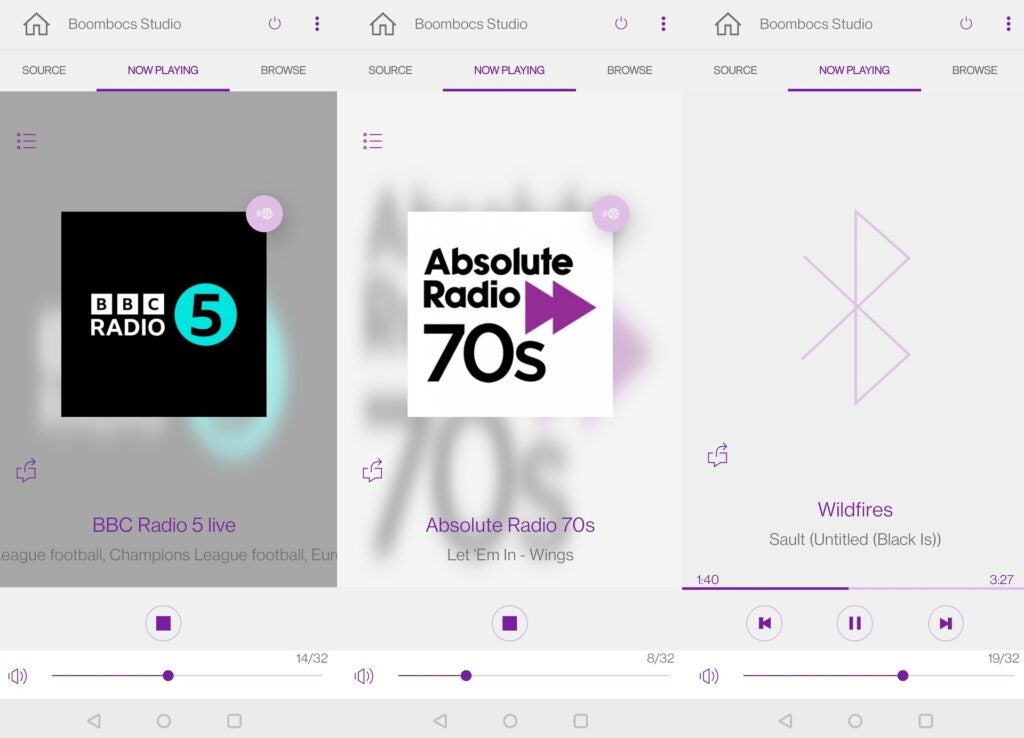
The integration of onboard controls and the Undok app is simple enough in terms of synchronisation, though I sense it could be further refined or some aspects made clearer.
Search is quicker on the app; the speaker makes the process more long-winded by scrolling and selecting each letter. The app is more responsive for most tasks but not all the speaker’s settings and information are accessible through it.
Setting the alarm clock only seems possible on the speaker, as is setting up a Bluetooth connection for the first time, though switching sources, managing presets, browsing, and playing music can also be done in the app.
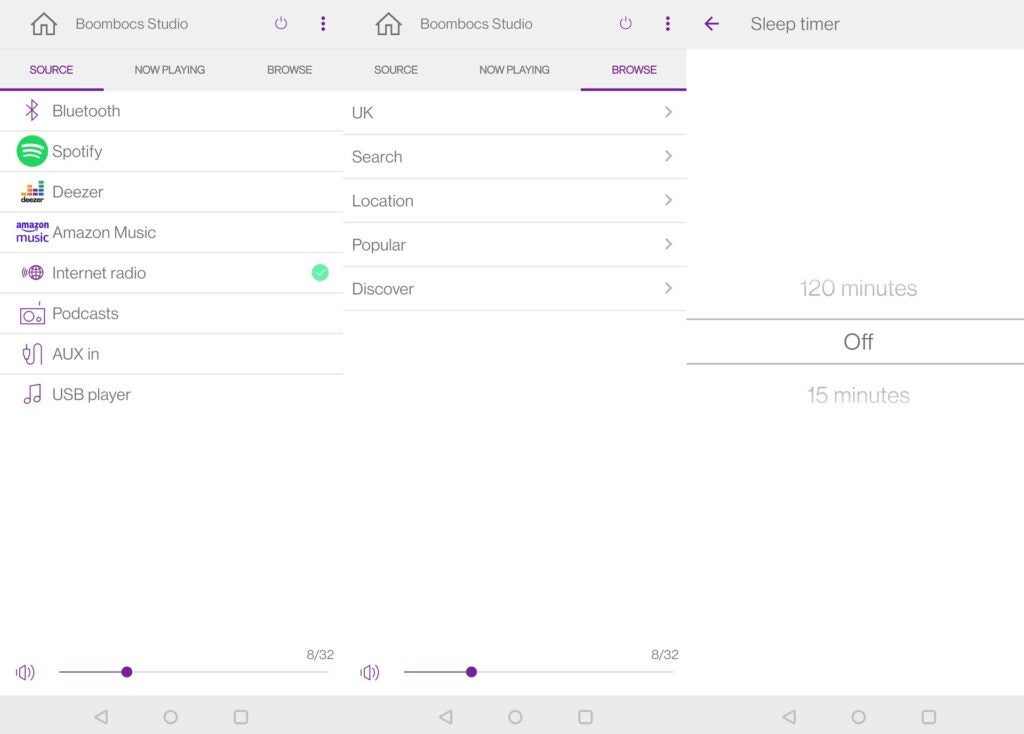
Presets are prime for some confusion. There are four presets for storing a station or source, and the ‘P+’ shows all saved radio stations. In truth there are four presets for each source, with presets only available when the source is in use.
If, say, you program the second preset for Amazon Music and are currently playing Internet Radio, pressing it won’t whisk you away to Amazon – presets aren’t ‘global’ across all sources but local, which is fine but might be cause for confusion. It also doesn’t help that when I was using Amazon Music, I couldn’t seem to save albums or playlists, just individual tracks.
You can also manage firmware updates through the app (or the speaker itself), though updating the speaker logs you out of apps, which means having to log back in via Undok.
Sound Quality
- Performance lacks sharpness, definition
- Limp bass performance
- Stereo presentation
The 2x 5W driver setup doesn’t promise much power, and the full range aluminium drivers aren’t particularly expressive of the full frequency spectrum either. The performance of the BoomBocs Studio lacks detail, definition, sharpness, or much clarity. Streaming from Amazon Music and there’s signal noise to contend with too. Compared to the Sonos Roam, or even a cheaper speaker like the Cleer Scene and the Studio, the BoomBocs lacks impact.
With Good Kid M.a.a.d City (Flat EQ) playing on both the BoomBocs and Roam, the bass is limper on the former despite being a much bigger speaker, and while vocals are foremost in the soundstage and presented with ok clarity, overall, there’s a lack of sharpness and definition across the frequency range. The top end lacks crispness, the soundstage is stodgily described, with a hoary definition to Kendrick Lamar’s vocals that falls flat.
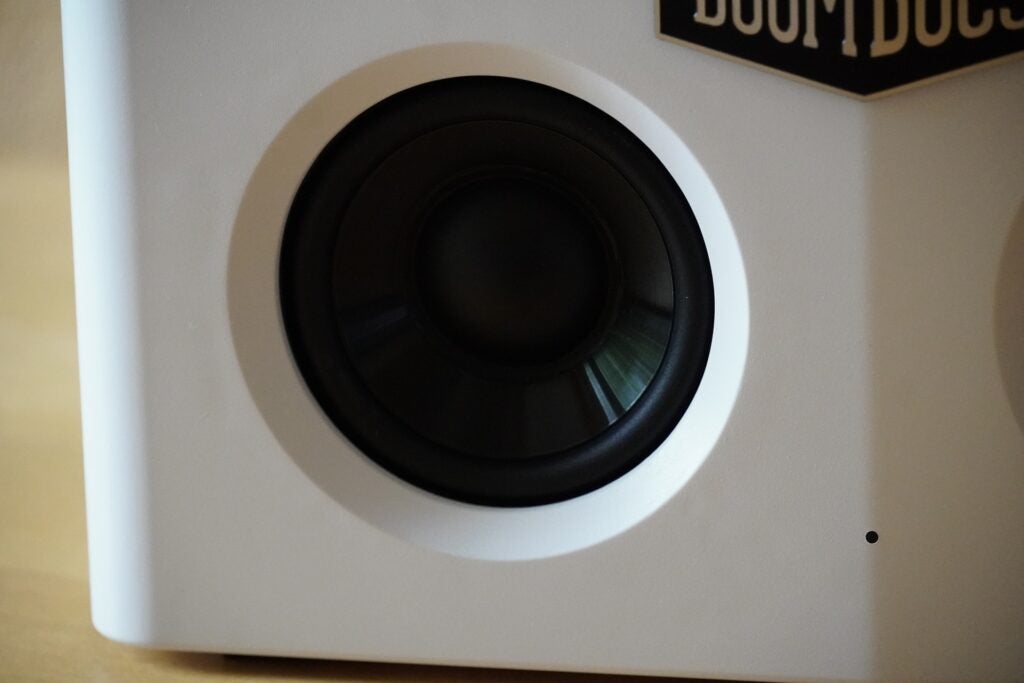
Playing around with the presets and while some are better than others (depending on what’s played), none resolve the audio issues. With Real from the Good Kid M.a.a.d City album bass is rather feebly described in its size and strength; tonally the Roam strikes a better balance with more dynamism, pomp, and flourish. The BoomBocs’ profile lacks depth and expansiveness, leading to a sound that feels boxed in.
The Classical preset works decently with soundtracks. The piano in the opening track of Cyrano is given some brightness to play with but again clarity is lacking. The Cleer Scene proves to be clearer as instruments strike a more natural tone. With Linkin Park’s Somewhere I Belong, there’s energy and decent thump to the low frequencies but its tonal balance and rhythmic skills are hazy and ill-defined. Similar issues affect Sault’s Wildfires over Bluetooth, the highs of her voice sound fuzzier with a noisiness to the signal too.
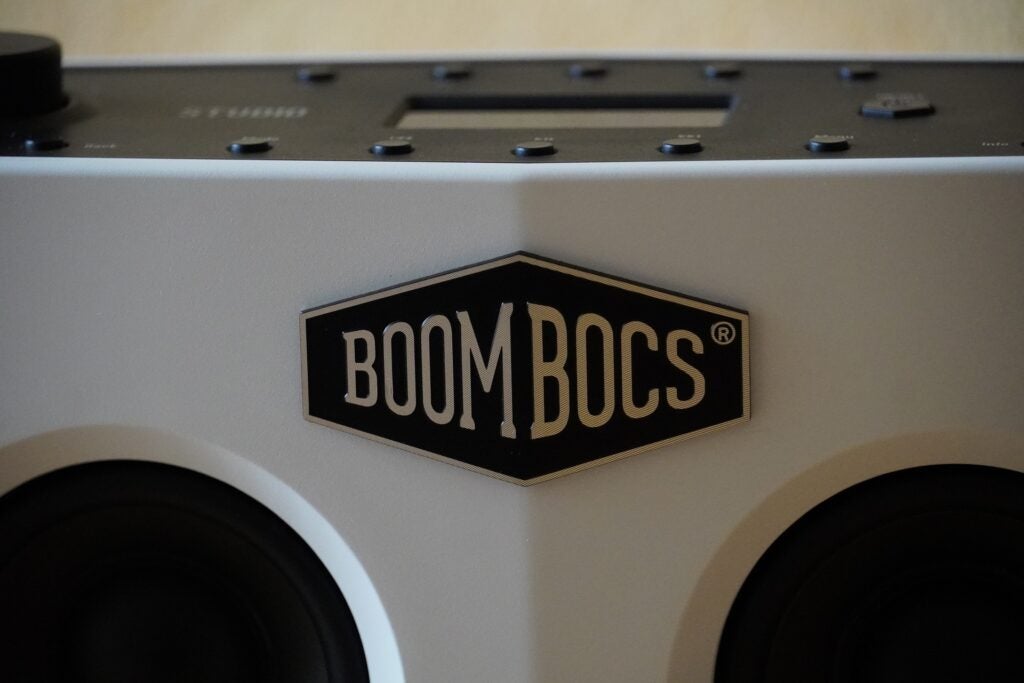
Listening to Internet radio and these issues are less of a problem, but I don’t generally expect radio to offer the best sound quality anyway. Tracks like Wings’ Let Me In and George Harrison’s My Sweet Lord on Absolute Radio 70s have adequate energy and detail, and perhaps an area where the BoomBocs has an advantage is that it is capable of some respectable stereo imaging. With the spoken word, there’s weight and smoothness that avoids sibilance – it sounds much better suited to radio than it does with music.
Latest deals
Should you buy it?
If you’re in the mix for a versatile wireless speaker:
Bluetooth, Wi-Fi, and Internet radio all in one package for less than £150. On paper the BoomBocs Studio offers pretty good value.
You take underwhelming audio as an affront:
Despite all the connection options, the Studio’s sound lacks clarity, definition, or vibrancy. It’s a lukewarm effort.
Final Thoughts
The BoomBocs Studio offers features you wouldn’t expect at this price point, but is outperformed where it counts: sound quality. Go a bit more expensive or lower and there are better sounding wireless speakers. Its ace in the hole is Wi-Fi and Bluetooth support, but this counts for less when the audio is lacklustre.
The BoomBocs Studio is a good idea, but its middling audio doesn’t make the most of the features it has at its disposal.
How we test
We test every wireless speaker we review thoroughly over an extended period of time. We use industry standard tests to compare features properly. We’ll always tell you what we find. We never, ever, accept money to review a product.
Find out more about how we test in our ethics policy.
Compared to similarly priced speakers
Tested with real world use
FAQs
The BoomBocs doesn’t support either AirPlay, Tidal Connect or Chromecast, but there’s built-in support for Spotify Connect, Deezer and Amazon Music streaming services.
Sustainability
Trusted Reviews’ holds the fact that global warming is not a myth as a core value and will continuously endeavour to help protect our planet from harm in its business practices.
As part of this mission, whenever we review a product we send the company a series of questions to help us gauge and make transparent the impact the device has on the environment.
We currently haven’t received answers to the questions on this product, but will update this page the moment we do. You can see a detailed breakdown of the questions we ask and why in our sustainability info page.
Jargon buster
Bluetooth
Bluetooth – named after 10th-century Danish king Harald Bluetooth who united Denmark’s tribes into a single kingdom – is a method of wireless transmission that allows for the exchange of data between devices over short distances.
A wireless speaker that can pull double duties as an Internet radio, but the BoomBocs Studio is undone by some underwhelming audio.
Pros
- Wi-Fi and Bluetooth for less than £150
- Trendy look
- Music streaming support
Cons
- Below par sound short of definition, detail, and bass
- Navigation on speaker can be long-winded
- Noisy signal
Availability
- UKRRP: £149
- USATBC
- EuropeTBC
- CanadaTBC
- AustraliaTBC
-
Music streamingSupports Amazon Music, Deezer, Spotify Connect and Internet radio -
RadioTwo alarms and sleep/snooze functionality -
Undok appApp for controlling device on mobile (Android/iOS)
Introduction
Are you old enough to remember a boombox? If not, perhaps a history lesson is required.
Back in the eighties, people would haul humongous speakers around, slip in a cassette and let rip on a street for everyone to hear (even if they didn’t want to). Play the right music, and it was a party starter.
Of course, we’re no longer in the 1980s, and speakers are small enough to be carried with one hand. The BoomBocs Studio fits such a description and is filled with modern tech such as Bluetooth and Wi-Fi connectivity.
Revivifying the 80s is all well and good, but the BoomBocs Studio needs to be more than a melding of nostalgia and modern sensibilities to have an impact.
Design
- Rotary dials for control
- LCD display
- Comes in a range of colours
The BoomBocs Studio is larger than most wireless speakers, but still compact enough to perch on a tabletop or desk, though not enclosed within a closed bookshelf as it requires air for ventilation.
It comes in a variety of quirkily named and snazzy colour options such as Green Quartz, Dahlia Orange, Pink Charlotte, Brilliant White and Bold Black. There’s a slight indentation in the middle that gives the Studio an angular look, casting the speaker in two shades when light shines upon it.

Around the rear is an integrated handle for carry, the speaker weighs a lightweight 1.43 kg. That’s less than the Apple HomePod 2 and less than ‘portable’ speakers such as the Sonos Move and Sony SRS-XG300.
At the bottom are 3.5mm aux in and type-A USB ports for playback plus an input for the power supply.

Up top are two rotary dials: one for volume and another for navigation. And slap bam in the middle is a 2.4-inch LCD display. It is (sort of) visible from afar but you’ll need to be hovering over to read the text. Above that screen are five programmable presets and below are buttons for playback, menu, info etc.
I do like the tactility of the dials and buttons, it gives the speaker a playful, toy-like sensibility, though some (but not all) of the menu settings and search capabilities are rendered pointless by also being available in the Undok app, so you won’t need to use them as much if you have a smartphone.

Features
- Wi-Fi and Bluetooth connectivity
- Up to 15 hours battery life
- Four presets for each source
There aren’t many wireless speakers below £150 that offer Bluetooth 5.0 and Wi-Fi, but the BoomBocs has both, permitting access to the likes of Spotify Connect, Deezer, Amazon Music, Internet radio and podcasts. Chromecast and AirPlay aren’t included but that level of support is rare at this price.
And the BoomBocs Studio functions as a radio too, with alarm capability (two of them) and sleep/snooze support too –the last feature is one the similarly specced (and more expensive) Pure Evoke Play leaves off its list.

The rechargeable battery is rated in the region of 10-15 hours (15 for Bluetooth, 12 with Wi-Fi) and though the BoomBocs comes with a power adapter, it runs off the internal battery and only needs the adapter to charge back to full, after which it should be unplugged to keep the battery ‘healthy’. There’s a four-bar icon in the bottom-right corner of the display that shows how much is left.
The internal battery allows the Studio to function more as a portable speaker to move around the home, but would you take it outside? Perhaps to the garden, but with no IP rating I wouldn’t suggest placing it next to liquids.
Like the Pure Evoke Play, the BoomBocs Studio supports the Undok app (Android, iOS) where you can login to streaming apps, tee up songs and playlists, and switch equaliser modes (a choice of Normal, Flat, Jazz, Rock, Movie, Classic, Pop, News, with a Custom EQ that allows for bass, treble, and loudness correction).

The integration of onboard controls and the Undok app is simple enough in terms of synchronisation, though I sense it could be further refined or some aspects made clearer.
Search is quicker on the app; the speaker makes the process more long-winded by scrolling and selecting each letter. The app is more responsive for most tasks but not all the speaker’s settings and information are accessible through it.
Setting the alarm clock only seems possible on the speaker, as is setting up a Bluetooth connection for the first time, though switching sources, managing presets, browsing, and playing music can also be done in the app.

Presets are prime for some confusion. There are four presets for storing a station or source, and the ‘P+’ shows all saved radio stations. In truth there are four presets for each source, with presets only available when the source is in use.
If, say, you program the second preset for Amazon Music and are currently playing Internet Radio, pressing it won’t whisk you away to Amazon – presets aren’t ‘global’ across all sources but local, which is fine but might be cause for confusion. It also doesn’t help that when I was using Amazon Music, I couldn’t seem to save albums or playlists, just individual tracks.
You can also manage firmware updates through the app (or the speaker itself), though updating the speaker logs you out of apps, which means having to log back in via Undok.
Sound Quality
- Performance lacks sharpness, definition
- Limp bass performance
- Stereo presentation
The 2x 5W driver setup doesn’t promise much power, and the full range aluminium drivers aren’t particularly expressive of the full frequency spectrum either. The performance of the BoomBocs Studio lacks detail, definition, sharpness, or much clarity. Streaming from Amazon Music and there’s signal noise to contend with too. Compared to the Sonos Roam, or even a cheaper speaker like the Cleer Scene and the Studio, the BoomBocs lacks impact.
With Good Kid M.a.a.d City (Flat EQ) playing on both the BoomBocs and Roam, the bass is limper on the former despite being a much bigger speaker, and while vocals are foremost in the soundstage and presented with ok clarity, overall, there’s a lack of sharpness and definition across the frequency range. The top end lacks crispness, the soundstage is stodgily described, with a hoary definition to Kendrick Lamar’s vocals that falls flat.

Playing around with the presets and while some are better than others (depending on what’s played), none resolve the audio issues. With Real from the Good Kid M.a.a.d City album bass is rather feebly described in its size and strength; tonally the Roam strikes a better balance with more dynamism, pomp, and flourish. The BoomBocs’ profile lacks depth and expansiveness, leading to a sound that feels boxed in.
The Classical preset works decently with soundtracks. The piano in the opening track of Cyrano is given some brightness to play with but again clarity is lacking. The Cleer Scene proves to be clearer as instruments strike a more natural tone. With Linkin Park’s Somewhere I Belong, there’s energy and decent thump to the low frequencies but its tonal balance and rhythmic skills are hazy and ill-defined. Similar issues affect Sault’s Wildfires over Bluetooth, the highs of her voice sound fuzzier with a noisiness to the signal too.

Listening to Internet radio and these issues are less of a problem, but I don’t generally expect radio to offer the best sound quality anyway. Tracks like Wings’ Let Me In and George Harrison’s My Sweet Lord on Absolute Radio 70s have adequate energy and detail, and perhaps an area where the BoomBocs has an advantage is that it is capable of some respectable stereo imaging. With the spoken word, there’s weight and smoothness that avoids sibilance – it sounds much better suited to radio than it does with music.
Latest deals
Should you buy it?
If you’re in the mix for a versatile wireless speaker:
Bluetooth, Wi-Fi, and Internet radio all in one package for less than £150. On paper the BoomBocs Studio offers pretty good value.
You take underwhelming audio as an affront:
Despite all the connection options, the Studio’s sound lacks clarity, definition, or vibrancy. It’s a lukewarm effort.
Final Thoughts
The BoomBocs Studio offers features you wouldn’t expect at this price point, but is outperformed where it counts: sound quality. Go a bit more expensive or lower and there are better sounding wireless speakers. Its ace in the hole is Wi-Fi and Bluetooth support, but this counts for less when the audio is lacklustre.
The BoomBocs Studio is a good idea, but its middling audio doesn’t make the most of the features it has at its disposal.
How we test
We test every wireless speaker we review thoroughly over an extended period of time. We use industry standard tests to compare features properly. We’ll always tell you what we find. We never, ever, accept money to review a product.
Find out more about how we test in our ethics policy.
Compared to similarly priced speakers
Tested with real world use
FAQs
The BoomBocs doesn’t support either AirPlay, Tidal Connect or Chromecast, but there’s built-in support for Spotify Connect, Deezer and Amazon Music streaming services.
Sustainability
Trusted Reviews’ holds the fact that global warming is not a myth as a core value and will continuously endeavour to help protect our planet from harm in its business practices.
As part of this mission, whenever we review a product we send the company a series of questions to help us gauge and make transparent the impact the device has on the environment.
We currently haven’t received answers to the questions on this product, but will update this page the moment we do. You can see a detailed breakdown of the questions we ask and why in our sustainability info page.
Jargon buster
Bluetooth
Bluetooth – named after 10th-century Danish king Harald Bluetooth who united Denmark’s tribes into a single kingdom – is a method of wireless transmission that allows for the exchange of data between devices over short distances.



